冀教版小学英语六年级上册第5课
- 格式:pptx
- 大小:530.28 KB
- 文档页数:16
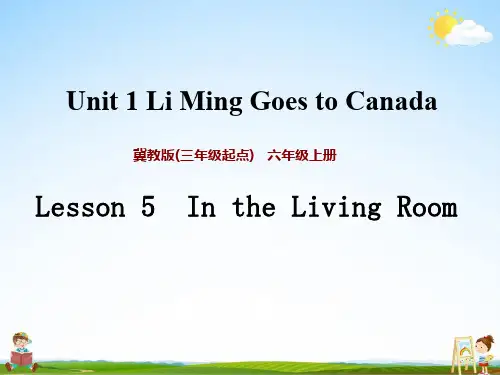
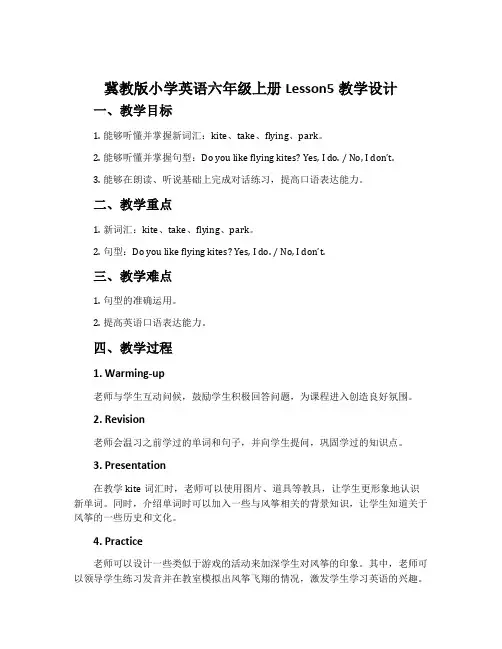
冀教版小学英语六年级上册Lesson5教学设计一、教学目标1.能够听懂并掌握新词汇:kite、take、flying、park。
2.能够听懂并掌握句型:Do you like flying kites? Yes, I do. / No, I don’t.3.能够在朗读、听说基础上完成对话练习,提高口语表达能力。
二、教学重点1.新词汇:kite、take、flying、park。
2.句型:Do you like flying kites? Yes, I do. / No, I don’t.三、教学难点1.句型的准确运用。
2.提高英语口语表达能力。
四、教学过程1. Warming-up老师与学生互动问候,鼓励学生积极回答问题,为课程进入创造良好氛围。
2. Revision老师会温习之前学过的单词和句子,并向学生提问,巩固学过的知识点。
3. Presentation在教学kite词汇时,老师可以使用图片、道具等教具,让学生更形象地认识新单词。
同时,介绍单词时可以加入一些与风筝相关的背景知识,让学生知道关于风筝的一些历史和文化。
4. Practice老师可以设计一些类似于游戏的活动来加深学生对风筝的印象。
其中,老师可以领导学生练习发音并在教室模拟出风筝飞翔的情况,激发学生学习英语的兴趣。
5. Drill老师可以提出以下问题,引导学生进行口语对话练习:•Do you like flying kites?•Yes, I do.•No, I don’t.学生也可以同样的问题向其他同学提出询问,慢慢巩固句型表达。
6. Homework布置一些有关于风筝的复习作业,如绘制风筝、描述风筝的形状大小颜色等等。
五、教学建议1.教师应利用多样化的教材和教具,比如《冀教版小学英语》教材、图片、道具以及教学活动等等,让学生能够在更有趣的环境下学习,提高学生的学习兴趣。
2.在教学中,要尊重学生的学习兴趣和习惯,注重培养学生口语表达的能力。
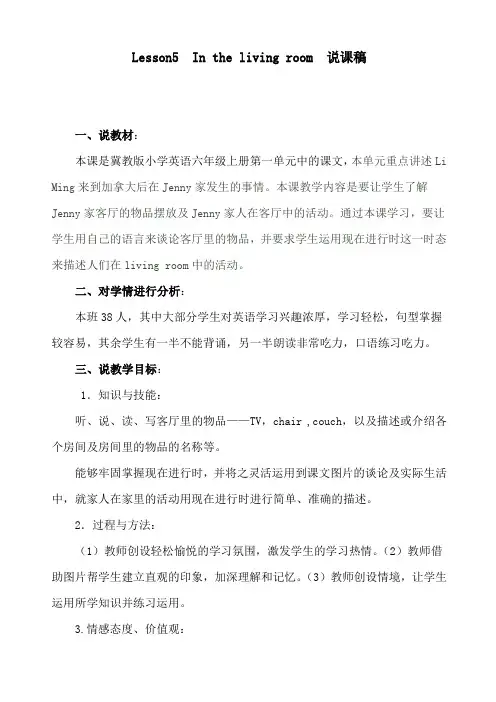
Lesson5 In the living room 说课稿一、说教材:本课是冀教版小学英语六年级上册第一单元中的课文,本单元重点讲述Li Ming来到加拿大后在Jenny家发生的事情。
本课教学内容是要让学生了解Jenny家客厅的物品摆放及Jenny家人在客厅中的活动。
通过本课学习,要让学生用自己的语言来谈论客厅里的物品,并要求学生运用现在进行时这一时态来描述人们在living room中的活动。
二、对学情进行分析:本班38人,其中大部分学生对英语学习兴趣浓厚,学习轻松,句型掌握较容易,其余学生有一半不能背诵,另一半朗读非常吃力,口语练习吃力。
三、说教学目标:1.知识与技能:听、说、读、写客厅里的物品——TV,chair ,couch,以及描述或介绍各个房间及房间里的物品的名称等。
能够牢固掌握现在进行时,并将之灵活运用到课文图片的谈论及实际生活中,就家人在家里的活动用现在进行时进行简单、准确的描述。
2.过程与方法:(1)教师创设轻松愉悦的学习氛围,激发学生的学习热情。
(2)教师借助图片帮学生建立直观的印象,加深理解和记忆。
(3)教师创设情境,让学生运用所学知识并练习运用。
3.情感态度、价值观:(1)努力为学生创设轻松、活泼的课堂氛围,激发激发学生听英语、说英语、用英语和他人进行交流的兴趣,敢于用英语进行表达,并能主动利用语言环境大胆实践。
(2)让学生在情境中体验学习英语的快乐,使学生保持兴趣,树立自信。
鼓励学生根据所学知识谈论自己家客厅的物品及家人,使之能在小组活动中积极参与他人合作,互相帮助,增强学生的团结合作意识。
(3)通过学习客厅物品及能家人的描述,教育学生珍惜亲情,热爱家庭,增强学生对家的热爱及对父母的尊重。
教学重点、教学难点:重点:掌握客厅里的物品单词。
如:TV,chair ,couch掌握动词短语。
如:watch TV,read the newspaper ,play cards, write a letter ,sit in the chair ,sit on the couch.现在进行时的理解、掌握和运用。
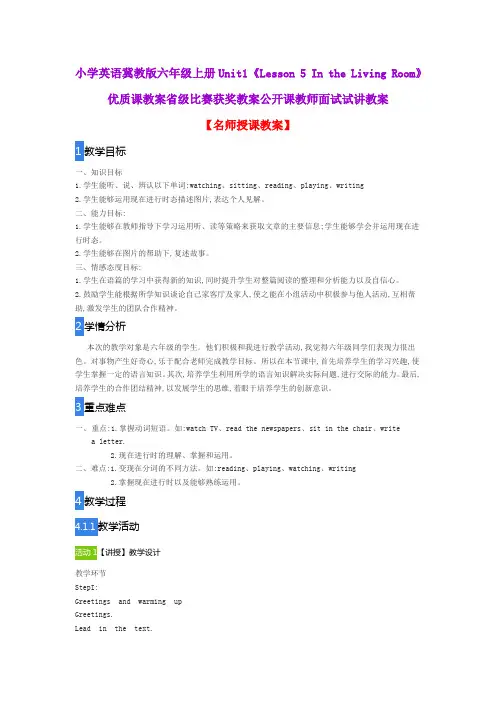
小学英语冀教版六年级上册Unit1《Lesson 5 In the Living Room》优质课教案省级比赛获奖教案公开课教师面试试讲教案【名师授课教案】1教学目标一、知识目标1.学生能听、说、辨认以下单词:watching、sitting、reading、playing、writing2.学生能够运用现在进行时态描述图片,表达个人见解。
二、能力目标:1.学生能够在教师指导下学习运用听、读等策略来获取文章的主要信息;学生能够学会并运用现在进行时态。
2.学生能够在图片的帮助下,复述故事。
三、情感态度目标:1.学生在语篇的学习中获得新的知识,同时提升学生对整篇阅读的整理和分析能力以及自信心。
2.鼓励学生能根据所学知识谈论自己家客厅及家人,使之能在小组活动中积极参与他人活动,互相帮助,激发学生的团队合作精神。
2学情分析本次的教学对象是六年级的学生。
他们积极和我进行教学活动,我觉得六年级同学们表现力很出色。
对事物产生好奇心,乐于配合老师完成教学目标。
所以在本节课中,首先培养学生的学习兴趣,使学生掌握一定的语言知识。
其次,培养学生利用所学的语言知识解决实际问题,进行交际的能力。
最后,培养学生的合作团结精神,以发展学生的思维,着眼于培养学生的创新意识。
3重点难点一、重点:1.掌握动词短语。
如:watch TV、read the newspapers、sit in the chair、writea letter.2.现在进行时的理解、掌握和运用。
二、难点:1.变现在分词的不同方法。
如:reading、playing、watching、writing2.掌握现在进行时以及能够熟练运用。
4教学过程教学活动1【讲授】教学设计教学环节StepI:Greetings and warming upGreetings.Lead in the text.。
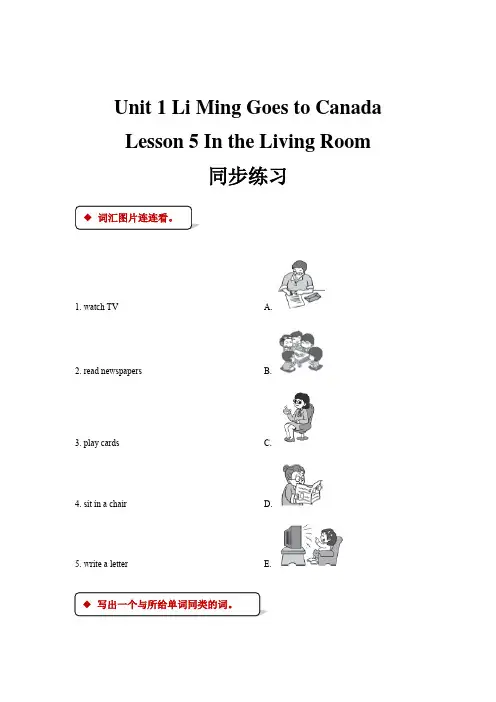
Unit 1 Li Ming Goes to Canada Lesson 5 In the Living Room同步练习1. watch TV A.2. read newspapersB.3. play cards C.4. sit in a chair D.5. write a letter E.1. bathroom bedroom ________2. lunch dinner ________3. them us ________4. chair table ________5. sit watch ________1. Can you look ________ us?A. inB. ofC. at2. Mr. and Mrs. Smith are ________ the newspaper.A. watchingB. lookingC. reading3. Where ________ they dancing?A. areB. isC. am4. —Do you like this show?—________A. Yes, I do.B. Yes, I can.C. Yes, I did.5. The cat is playing ________ a chair.A. forB. inC. tohim,you,me,We,them1. —Are ________ ready?—Yes, I am.2. ________ are in the living room.3. Mum tells ________ a story.4. Let’s help ________ water the flowers.5. Mr. and Mrs. Smith are reading newspapers. Lynn is in front of ________.例如:—What is my brother doing?—He is eating ice cream.1. —What is my mother doing?—______________________________2. —What is my sister doing?—______________________________3. —What is my father doing?—______________________________4. —What is my uncle doing?—______________________________5. —What am I doing?—______________________________参考答案1—E2—D3—B4—C5—A解析:此部分主要考察学生对单词的掌握。
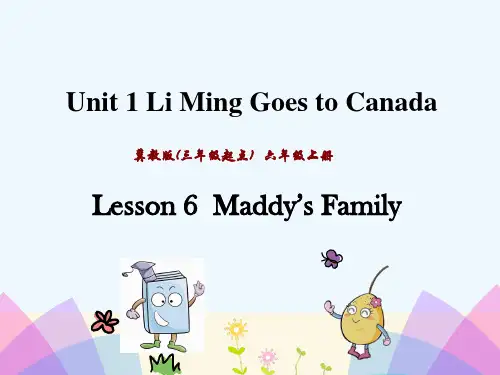
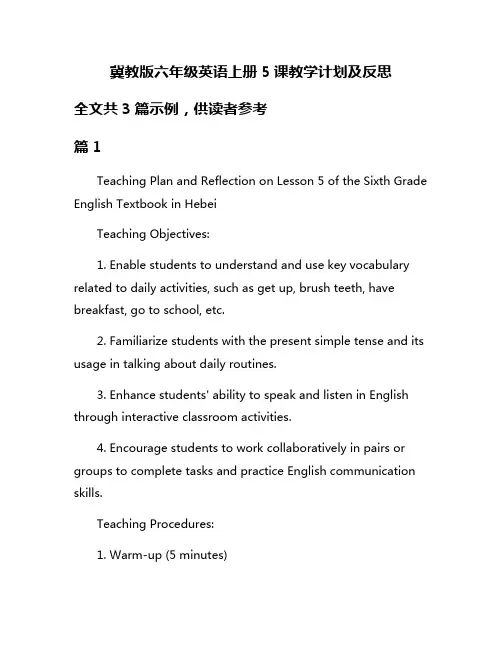
冀教版六年级英语上册5课教学计划及反思全文共3篇示例,供读者参考篇1Teaching Plan and Reflection on Lesson 5 of the Sixth Grade English Textbook in HebeiTeaching Objectives:1. Enable students to understand and use key vocabulary related to daily activities, such as get up, brush teeth, have breakfast, go to school, etc.2. Familiarize students with the present simple tense and its usage in talking about daily routines.3. Enhance students' ability to speak and listen in English through interactive classroom activities.4. Encourage students to work collaboratively in pairs or groups to complete tasks and practice English communication skills.Teaching Procedures:1. Warm-up (5 minutes)- Greet the students and ask them how they are feeling today.- Review the vocabulary from the previous lesson by playing a quick vocabulary game or matching activity.2. Presentation (15 minutes)- Introduce the new vocabulary words related to daily activities through flashcards or pictures.- Use realia or props to demonstrate the actions and have students repeat after you.- Model sentences using the present simple tense and encourage students to identify the verb forms.3. Practice (20 minutes)- Divide the class into pairs or small groups and give them a worksheet with questions about their daily routines.- Monitor their conversations and provide feedback on their use of vocabulary and grammar.- Have a few pairs share their routines with the class to promote speaking and listening skills.4. Production (15 minutes)- Ask students to create a daily routine poster or comic strip using the vocabulary and grammar structures learned in class.- Encourage creativity and teamwork as students work together to illustrate their routines.5. Review and Homework (5 minutes)- Recap the key points of the lesson and ask students to summarize what they have learned.- Assign homework, such as writing a diary entry about a typical day or practicing the present simple tense with exercises from the textbook.Reflection:Overall, the lesson went smoothly and achieved its objectives of introducing new vocabulary, practicing grammar structures, and promoting speaking skills. The students were engaged and enthusiastic about sharing their daily routines with their classmates. However, I noticed that some students struggled with pronunciation and verb forms, so I will include more pronunciation practice and drilling activities in future lessons. Additionally, I could provide more opportunities for students to speak individually or in small groups to build theirconfidence in using English. Overall, I am pleased with the progress the students have made and look forward to continuing to support their English learning journey.篇2Teaching Plan and Reflection on Lesson 5 of Grade 6 English Book in Hebei EditionPart One: Teaching PlanObjective:Students will be able to learn vocabulary related to weather, understand how to use the present continuous tense to talk about actions happening now, and practice speaking and writing sentences in English.Key Points:1. Vocabulary related to weather: sunny, windy, snowy, rainy, cloudy, cold, hot2. Present continuous tense: I am reading. He is playing basketball.3. Speaking and writing sentences in English.Teaching Procedures:1. Warm-up (5 minutes)- Greet the students and review the vocabulary from the previous lesson.- Show pictures of different weather conditions and ask students to identify them.2. Presentation (15 minutes)- Introduce new vocabulary related to weather (sunny, windy, snowy, rainy, cloudy, cold, hot) and practice pronunciation.- Explain the present continuous tense and provide examples.- Show pictures or videos of different weather conditions and have students describe them using the new vocabulary.3. Practice (20 minutes)- Have students work in pairs to ask and answer questions about the weather using the present continuous tense.- Play a weather forecasting game where students take turns being the weather reporter and describing the weather in different locations.4. Production (15 minutes)- Ask students to write sentences describing the weather in their city using the present continuous tense.- Have students present their sentences to the class.5. Review and Homework Assignment (5 minutes)- Review the key points of the lesson and ask students to practice writing sentences using the present continuous tense at home.Part Two: ReflectionOverall, the lesson went well and the students were engaged and actively participated in the activities. The use of visual aids such as pictures and videos helped students better understand the new vocabulary and the concept of the present continuous tense.One aspect that could be improved is to provide more opportunities for students to practice speaking in English. Although the pair work and weather forecasting game were effective, more speaking practice activities could help students become more confident in using English orally.In future lessons, I will also incorporate more interactive activities such as role plays and group discussions to further enhance students' language skills. Overall, I am satisfied with theprogress of the students and look forward to continuing to help them improve their English proficiency.篇3Teaching Plan and Reflection for Lesson 5 of the Sixth Grade English Textbook in Hebei ProvinceLesson Title: A Busy DayLesson Objectives:1. Students will be able to understand and use daily routine vocabulary.2. Students will be able to ask and answer questions about someone's daily routine.3. Students will be able to write short paragraphs describing their own daily routines.Materials Needed:- Textbook: A Busy Day- Flashcards with daily routine vocabulary- Whiteboard and markers- Worksheets for practice exercisesLesson Plan:1. Warm-up (10 minutes):- Greet the students and review the vocabulary from the previous lesson.- Introduce the topic of daily routines and ask students to share their own routines with the class.- Show flashcards of daily routine activities and have students identify the activities in English.2. Presentation (20 minutes):- Present the new vocabulary related to daily routines, such as "wake up", "brush teeth", "eat breakfast", etc.- Use gestures and pictures to help students understand the meanings of the new words.- Model sentences using the new vocabulary and have students repeat after you.3. Practice (15 minutes):- Divide the class into pairs and have them ask each other about their daily routines using the new vocabulary.- Circulate around the class to monitor students' progress and provide assistance when needed.- After the practice, ask a few pairs to share their conversations with the class.4. Production (20 minutes):- Distribute worksheets with prompts for students to write about their own daily routines.- Encourage students to use the new vocabulary they have learned in their writing.- Collect the worksheets at the end of the activity and provide feedback on students' writing.5. Conclusion (5 minutes):- Review the key points of the lesson and ask students if they have any questions.- Assign homework for the next lesson, such as writing a diary entry about a day in their life.Reflection:Overall, the lesson went well and most students were able to grasp the new vocabulary and use it in conversations and writtenexercises. However, some students struggled with spelling and grammar when writing about their daily routines, so in future lessons, I will focus more on these areas to help students improve their writing skills. Additionally, I will incorporate more interactive activities to engage all students and cater to different learning styles. It is important to create a supportive and inclusive learning environment where all students feel motivated and encouraged to participate. By reflecting on each lesson and making adjustments as needed, I can ensure that my students are making progress and developing their English language skills effectively.。
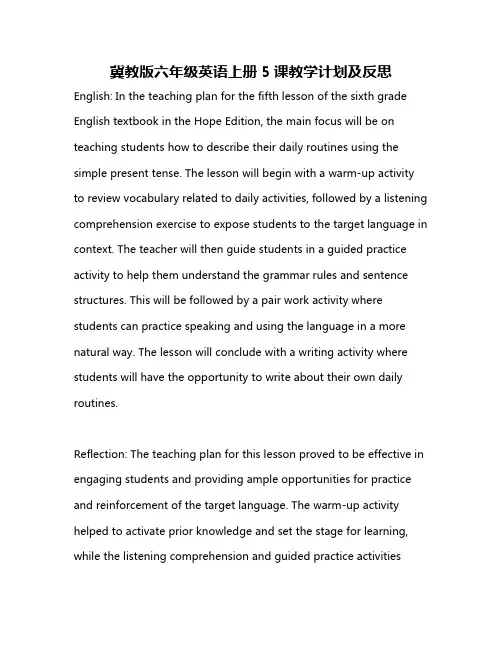
冀教版六年级英语上册5课教学计划及反思English: In the teaching plan for the fifth lesson of the sixth grade English textbook in the Hope Edition, the main focus will be on teaching students how to describe their daily routines using the simple present tense. The lesson will begin with a warm-up activity to review vocabulary related to daily activities, followed by a listening comprehension exercise to expose students to the target language in context. The teacher will then guide students in a guided practice activity to help them understand the grammar rules and sentence structures. This will be followed by a pair work activity where students can practice speaking and using the language in a more natural way. The lesson will conclude with a writing activity where students will have the opportunity to write about their own daily routines.Reflection: The teaching plan for this lesson proved to be effective in engaging students and providing ample opportunities for practice and reinforcement of the target language. The warm-up activity helped to activate prior knowledge and set the stage for learning, while the listening comprehension and guided practice activitiesallowed students to understand and internalize the new language. The pair work and writing activities provided opportunities for students to use the language in meaningful contexts and express their own ideas. However, one area for improvement could be to incorporate more interactive and hands-on activities to cater to different learning styles and keep students more actively engaged throughout the lesson.中文翻译: 在冀教版六年级英语教科书第五课的教学计划中,主要重点是教导学生如何用现在简单时态描述他们的日常生活。


新冀教版六年级上册英语教案集团标准化办公室:[VV986T-J682P28-JP266L8-68PNN]L e s s o n1A t t h e A i r p o r t一、教学目标(一)知识目标1.学生能听懂会读本课课文2.使学生通过练习复习句子:What time is it It’s ____.复习所学过的时间表达法。
(二)能力目标1.学生能够模仿课文对话,能练习相互问候的日常用语。
2.培养以旧带新掌握一定的语言技巧的能力,练习该如何表达时间。
(三)情感目标以情感培养人,培养学生珍惜时间的好习惯。
二、教学重点掌握what time is it It’s_三、教学难点学生能够准确的用英语表达时间。
四、教学用具录音机,磁带五、教学资源 2 : 10 two ten or two past ten. 4 : 30 four thirty or half past four. 9 : 00 nine o’clock or nine. 5 : 45 five forty-five or a quarter to six.六、教学过程:Step 1 : Review1) Play a game: “ The number game” to review number , play with numbers up to ten thousand .2) Review some phrases : What day is it What time is itStep 2 : Presentation and practice1.引出新课题,教授新单词airport,教读数遍并让学生明白单词的意思。
2.Ask and answer:1).Who is this Jenny\Danny\Li Ming.2).Where does Jenny live Canada. Where does Li Ming live China.3)How long is it from September 1 to June 25 Ss count the months: October November December January February…June. Wow!That’sten months.3.Teaching “ What time is it”1) 指着自己的手腕处,ask: What time is it (强调连读is it).Explain that we use “o’clock” only on the hour.2) Demonstrate : Draw a clock on the blackboard.More the hands on the clock as T asks and answer the question . Then get volunteers to answer the question . Eg: 2:40 two forty 5:10 five ten 6:37 six thirty seven 9:00 nine o’clock3.Practice :1) Practice in pairs .2)Ask the volunteers to more the hands on the clock as they ask and answer the question .4.Teaching “ the text ”1)When the students listen to the tape , think over the question :a.Why does LiMing come to Canadab.When does Li Ming arrive When will LiMing go homec.What time did Li Ming’s plane arrived.Who meets him at the airporte.Did he have a good trip2)Read the dialogue and discuss the questions in groups .3)Ask the students to answer the questions .4)Read by themselves , then read role-play .Step 3.HomeworkMake up a dialogue about meeting someone at the airport . Use“ What time is it It’s .”七、 BlackboardLesson 1 At the Airport5 o’clock ——What time is it6 o’clock ——It’s 5:25.教学反思:Lesson2 Jenny’s House一、教学目标:(一)知识目标:1、能听、说、读、写单词:bedroom; kitchen; bathroom; living room ,toilet ,study2、能用英语简单描述自己的家中的各个房间。
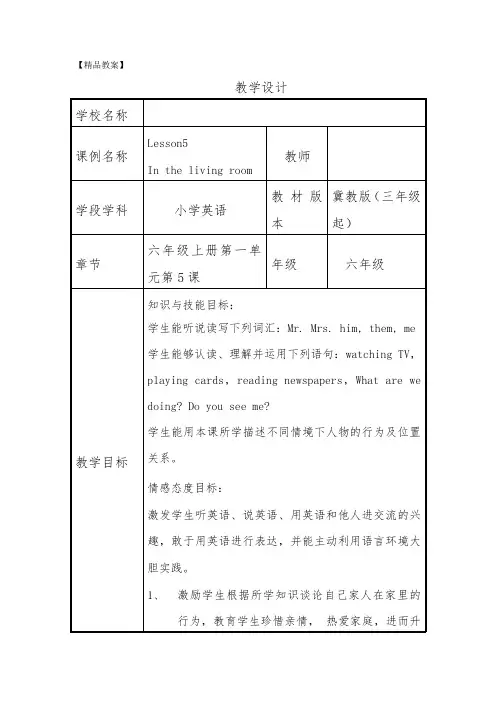
【精品教案】
教学设计
能力。
4、Read and find the rules. 学生读后找出宾格
的用法。
设计意图:学生读句子后找出人称代词宾格的使用规则。
有助于学生正确使用人称代词的宾格形式。
5、总结人称代词的主格和宾格用法。
设计
意图:主格与宾格的对比,让学生更直观的了解人称代词的主格和宾格,并区分它们的正确使用方法。
6、Practice
设计意图:检测学生对人称代词的掌握程度。
三、Consolidation and Extension
1、Sing an English song “W h at are you doing?”
2、Read , tick and cross .
3、Look , say and write.
4、小组内通过拍摄的家庭照片或视频向同学介绍自己
的家庭成员。
设
计
意
图:1.听英文歌曲是为了让学生在轻松愉悦中练习句型Wh at are you doing ? I’m …… 2.通过阅读理解检测学生的阅读理解能力。
3.通过看,说,写的方式练习学生的语言表达能力和写作能力,这是六年级学生应该具备的基本素质。
4.课前布置任务让学生用自己的平板拍摄家庭成员的活动的照片或视频,课上展示给同学,训练学生的语言表达能力和对家的热爱6、爱国教育。
告诉学生中国是我们的大家庭,我们都是成员,我们不仅爱自己的家,还要更加热爱我们的祖国。
六年级英语上册课本冀教版翻译第5课1 I dreaded Sundays. I began living for the weekend at 8:30 Monday mornings. I felt bitter towards my boss. (1) The thought of answering other people's telephones, typing other people's work and watching other people take credit for my ideas and opinions would throw me into week-long bouts of depression. I hated my job. I hated my life. I hated myself for not having the courage to change either one. 重新开始穆丽尔·L·韦特斯通我曾经惧怕星期天。
那时我从星期一上午八点半开始就盼着周末。
我痛恨我的老板。
每当我想起给别人回电话、打字,看到我出的主意和见解却让别人去受益时,常常整个星期都会闷闷不乐。
我痛恨我的工作。
我痛恨我的生活。
我痛恨自己既没有勇气改换工作,也没有勇气改变我的生活。
2 When most of my friends were planning college schedules and partying into the night, I was changing dirty diapers and walking the floor with a crying baby. At 19 years old I was the mother of two, and a pitifully young wife. Everything I did for years, every decision I made, was done with my family in mind. 当我的大多数的朋友都在计划上大学,欢聚至深更半夜时,我却在换脏尿布,抱着一个哭闹的孩子在屋里走来走去。
第一单元教学目的:1、掌握本单元的词汇。
如:Aa Bb Cc Dd book boy black等。
2、理解并能口头应答下列用语和句子How many do you have?Nice to meet you.What’s this? It’s a .What’s his /her name?等。
教学重点:掌握本单元的词汇及句子。
教学难点:理解句子并口头应答。
课时安排:8课时Lesson 1. At the AirportLesson 2. Jenny’s houseLesson3:Making BreakfastLesson4:In the BathroomLesson 5: Making Supper ?1112Lesson6: In the living room1315Lesson7 :Are you ready for a quiz ?161718L L e e s s s s o o n n88A A g g a a i i n n P P l l e e a a s s e e19第二单元教学目的:1、掌握以下词江:blue red yellow is on under six seven enght nine ten等。
2、理解并能口头应答下列用语和句子How many do you have?What colour is this? It’s .教学重点:本单元要求掌握的词汇和句子教学难点:理解并能口头应答重点句子。
课时安排:8课时20Lesson 9 On the school busalways usually neverLesson 10 Liming meets Jenny’s classesLesson 11:Mr. Wood Teaches a LessonLesson 12 : How Many Are There ?Lesson 13 : Always Do Your Homework !Lesson 14 Learn a New SongLesson 15 Are You Ready for a Quiz ?Lesson 16 : Again, Please!第三单元教学目的:1、掌握本单元的词汇:arm body ear ellow eye finger hand cold hot 等。
六年级上册英语(冀教版)Lesson23教案
2. Free talk:
T: Hello, boys and girls. Christmas is coming! Merry Christmas!
S: Merry Christmas! T: What do people do at Christmas?
S: They invite their family and friends to their house.
They give their family and friends gifts.
They sing Christmas songs.
They put up the Christmas tree
They write Christmas cards.
They buy Christmas gifts.…
T: And they open the Christmas gifts on Christmas morning. 听歌曲。
,感受氛围【设计意图】以师生
间的自然问候导入
到旧知识的复习,再
用旧知引入新知,教
学环节的自然过渡
使学生很快投入到
本课的学习中。
Step 2 Lead-in&Pre-reading 1.T: Oh, I see many
gifts on your desk.
They are
beautiful. This
morning we open our
gifts! (操练此重点
小组讨论
【设计意图】从学生
已有的语言知识和
生活经验出发,围绕
师生课前准备的礼
物展开讨论,大家对
彼此的礼物都感到。
冀教版小学英语六年级上册Unit 1 Lesson 5 In the Living Room一、教学分析:1、教学内容分析:本课主要围绕Li Ming和Jenny一家在客厅所做的事情这一话题展开学习,在讲述中需用到现在进行时态和人称代词的宾格形式。
学生之前已经对现在进行时态有了一定的认识和感知,并能在语境中对其加以应用。
而宾格是第一次如此系统完整的出现在同一节课的文本中,需要给学生以系统的感知,理解,并期望其在语境中能够加以熟练应用。
2、学生分析:授课对象为六年级学生,他们对宾格有初步的认识和感知,并能简单的应用诸如me, him, her等宾格形式的词汇进行简单造句。
因此,根据学生对知识的掌握情况,基于培养学生学习兴趣的目的,将本课内容进行整合,从而突出重难点,提高课堂效率和学生学习的积极性。
3、课型:语篇4、教学目标:●知识与技能:(1) 学生能听懂、会说、认读并书写下列词汇:me, him, card, them, Mr., Mrs.(2) 学生要能够认读、理解并运用下列用语:watching TV, reading newspapers,playing cards,sitting at a tableWhat are we doing?Do you see me?(3) 能够正确熟练地掌握现在进行时,并且能在谈论图片及实际生活交流中,用现在进行时进行简单、准确的描述。
(4) 能在情境中理解并应用宾格代词,并理解这一语法现象的表意功能。
能就正在发生的事情进行简单的交流和描述。
●过程与方法:1、让学生看起居室的图片进行描述,使他们对所学知识进行复习回忆,并加以运用;2、以语篇语境带动语言学习;3、通过听音判断、阅读回答问题、看图片填空等练习活动,加深学生对文本的理解以及知识的运用。
●情感态度:1、使学生体验学习、参与、合作、竞争的乐趣,树立学生学习英语的信心,培养其英语学习的兴趣;2、通过对家人的描述,教育学生对家的热爱,对父母的尊重。
Lesson 5 Making Supper【课前百事通】【目标导航船】1、 能够听、说、读、写单词:dishes, dirty, clean, wash, dry, 短语 :dry the dishesgood work, on the table , in the refrigerator , in the sink2、 能听懂、会说本课句型:What ’s for supper? She needs some vegetables. What are youdoing? This is … These are …并能把本课的句型用于日常交际中。
3、 重点要求掌握的单词和短语4. 难点句型What ’s for supper? She needs some vegetables. What are you doing? This is …These are …[导入一]今天,我们陪Jenny 帮妈妈做晚饭,饭后又陪Li Ming 帮 Mr. Smith 刷盘子。
这其中你一定掌握了重点单词:dishes , clean , dirty , wash , dry 以及句子:Let ’shelp my mother make supper. Please pass the peas! 我们要经常帮助妈妈做些力所能及的家务,争做懂事的好孩子。
[导入二]这是让学生复习学过的单词的游戏,教师先把需复习的20个但用简笔画画在小黑板上,先不要让学生生看到,然后让全班按前后左右四人一组分成若干组。
竞赛开始,教师将小黑板挂起来,让学生看一分钟,然后收起来,再给学生两分钟的时间将看到的单词写出来,写得最多最正确的组获胜。
[活动一]出示一个小塑料袋,拿起一位同学的文具一边往塑料袋里装一边说:I put it in the bag.然后讲解单词in , on 做个好孩子看图写单请一个小组的学生依次将文具往袋子里放,并说:I put it in the bag. 教师引导新句型:They are in the bag.归还文具后,请另一位学生将书包放到讲台上,并引导学生说:I put it on the desk. 然后请另一组学生依次将书包放在讲台上,教师说:They are on the desk.要求学生看教材10页中的图片。